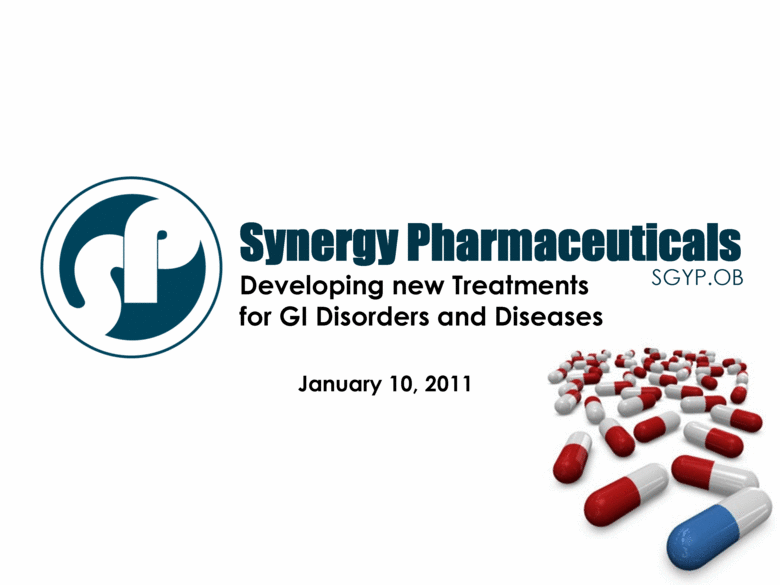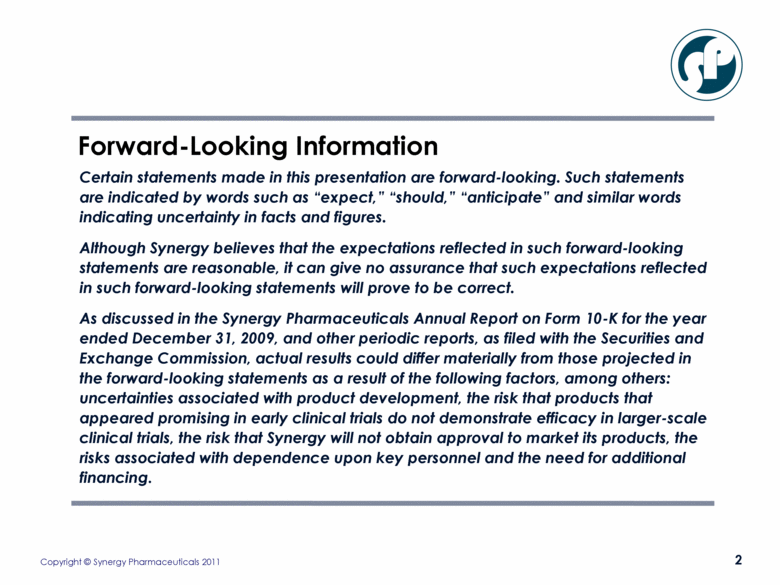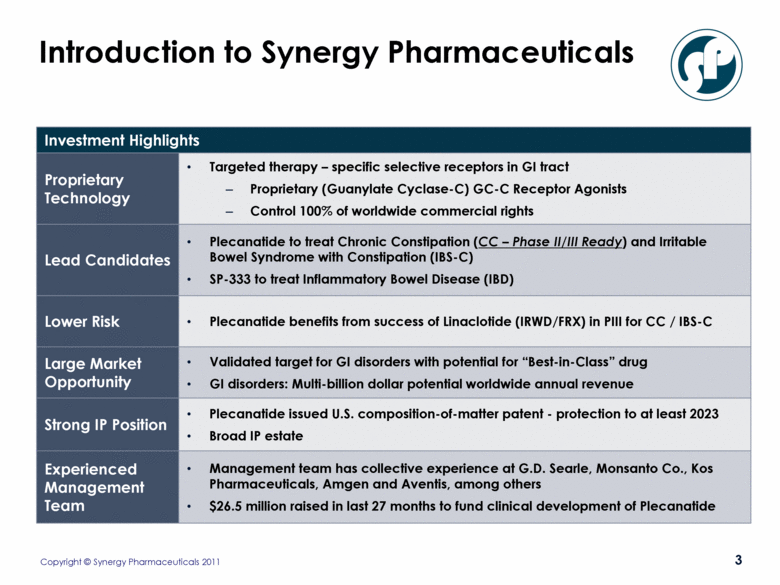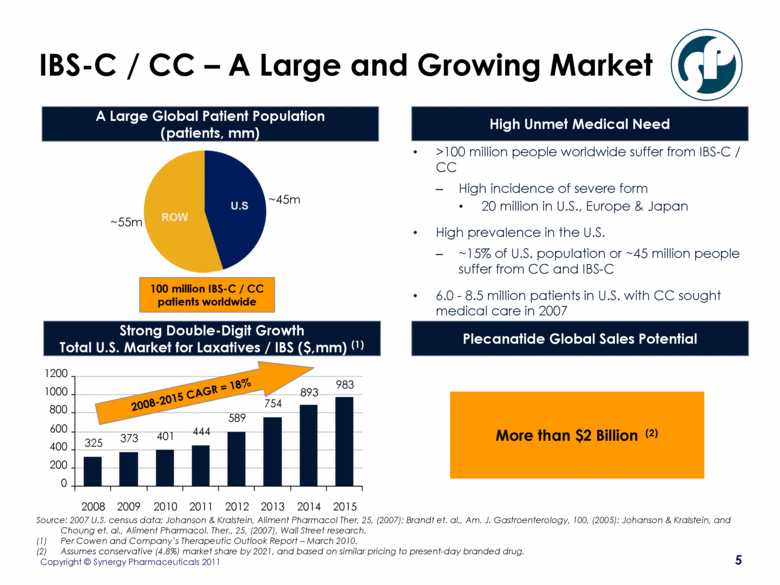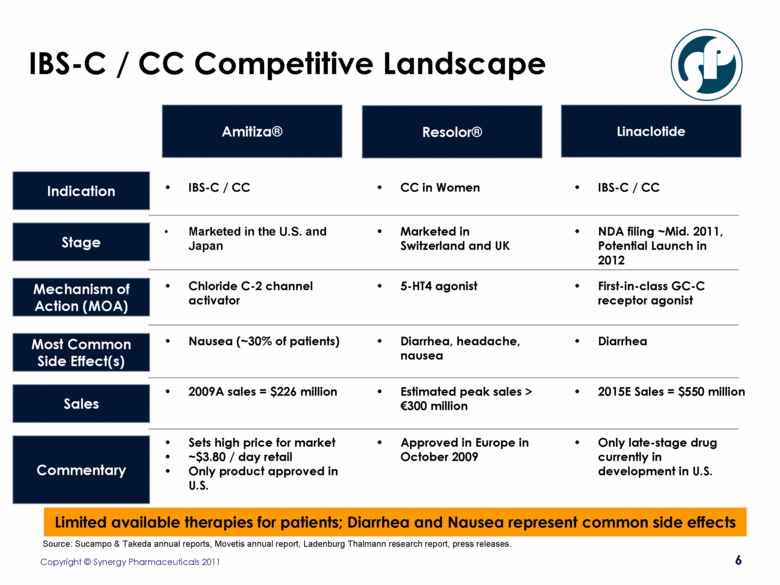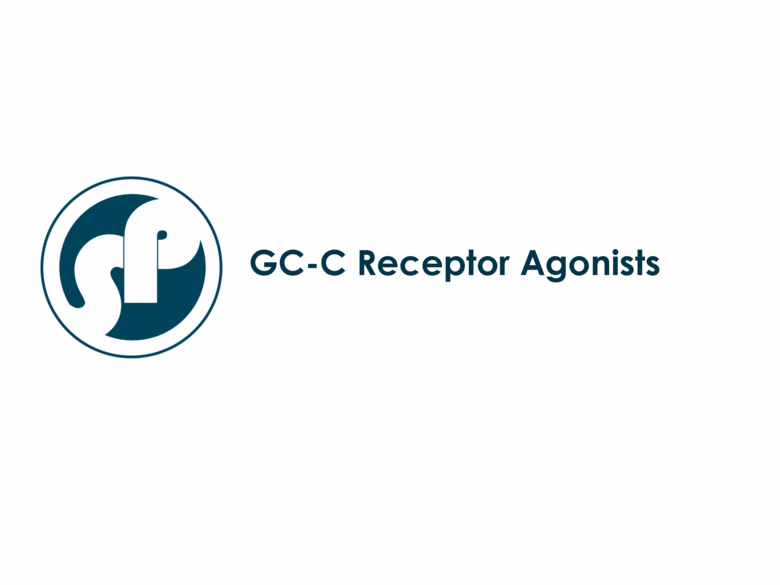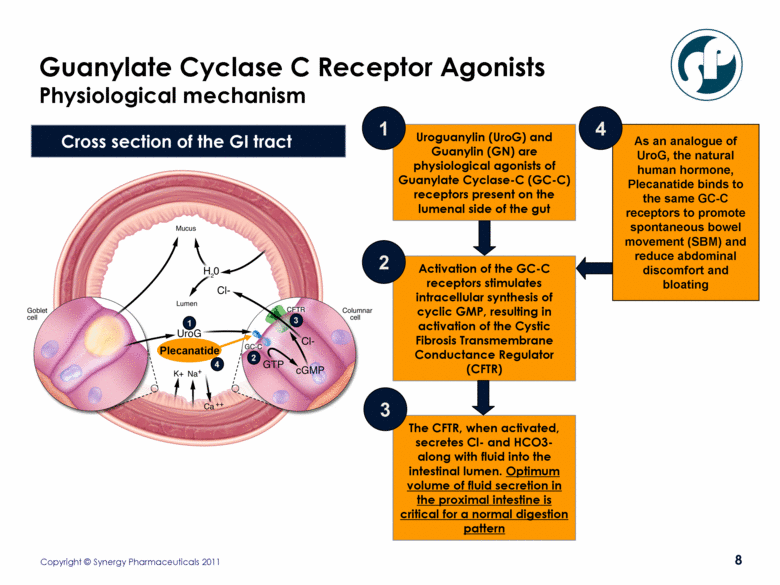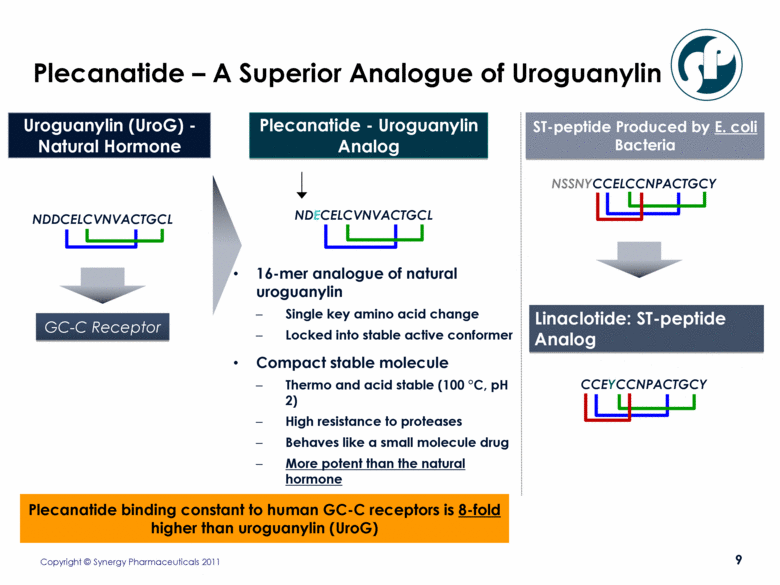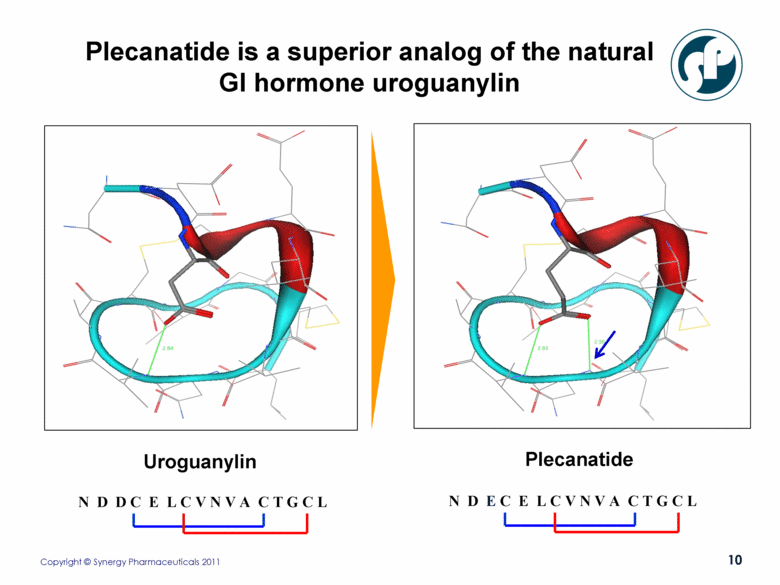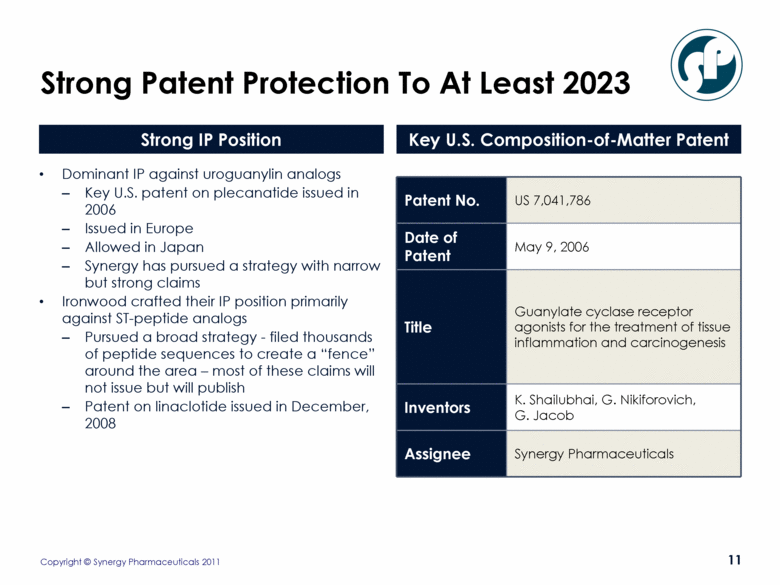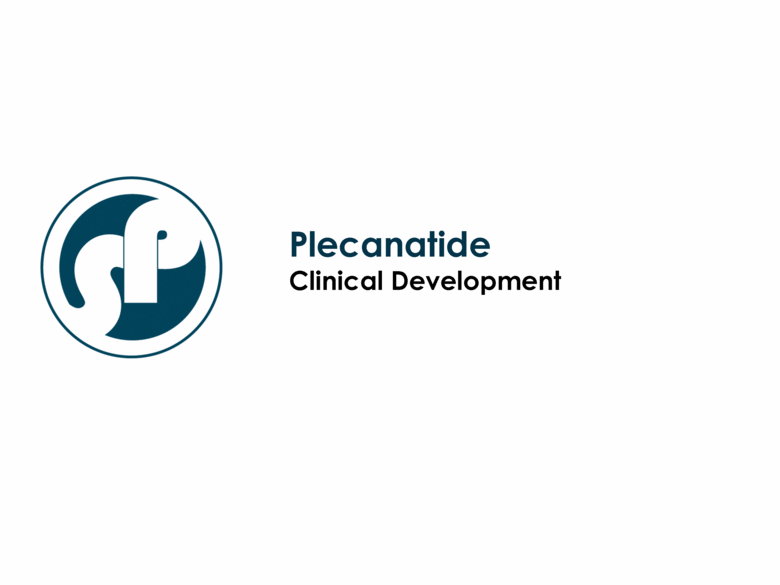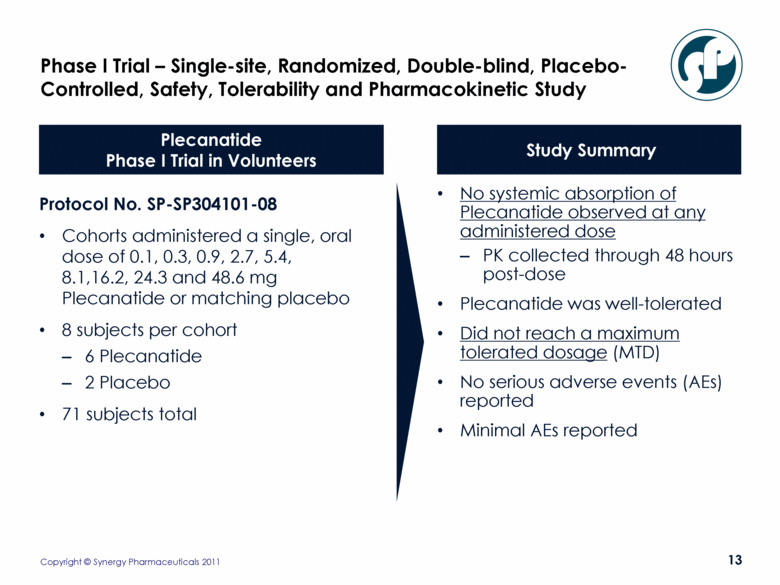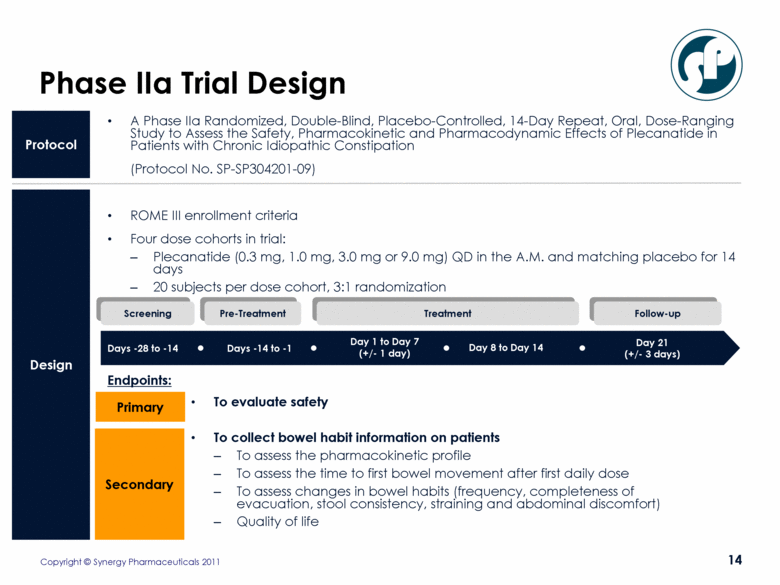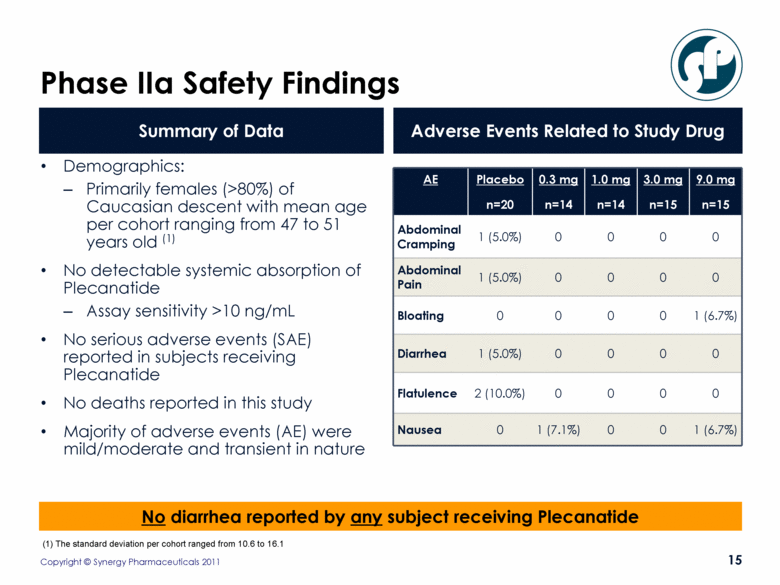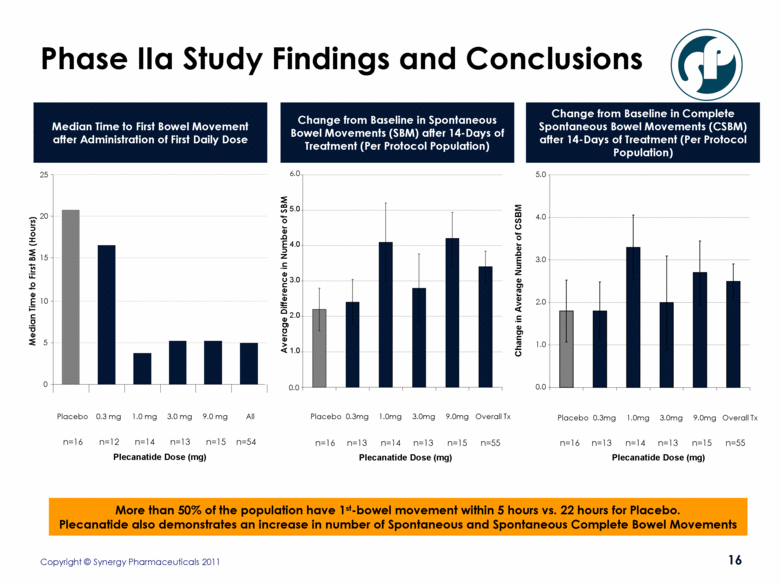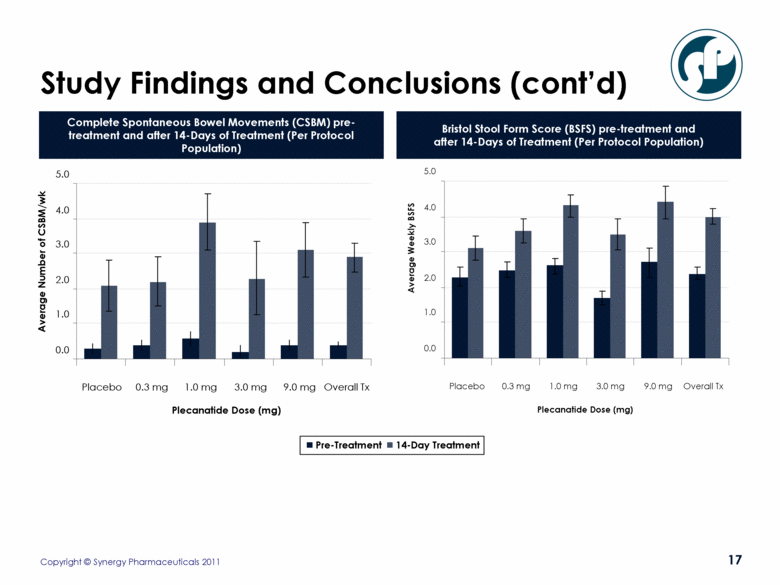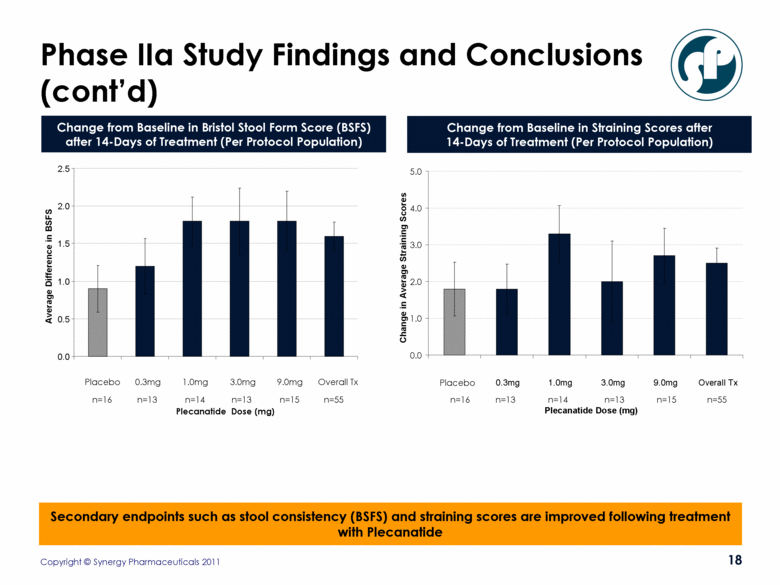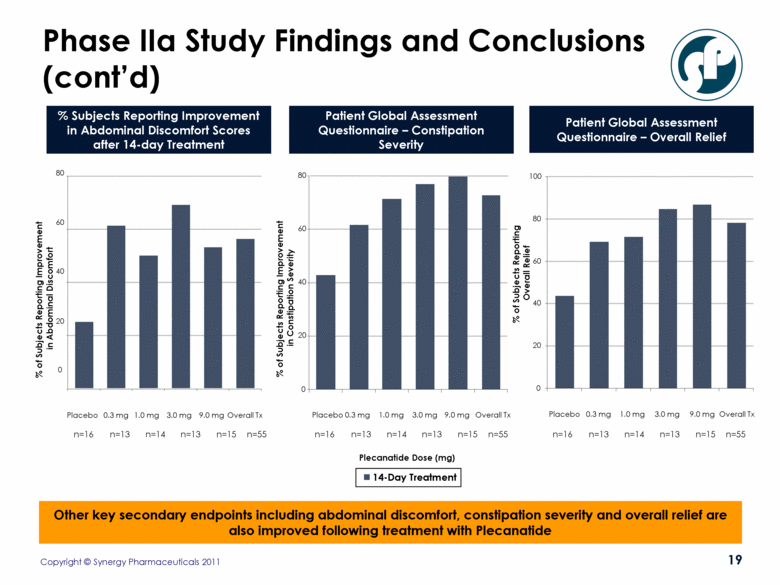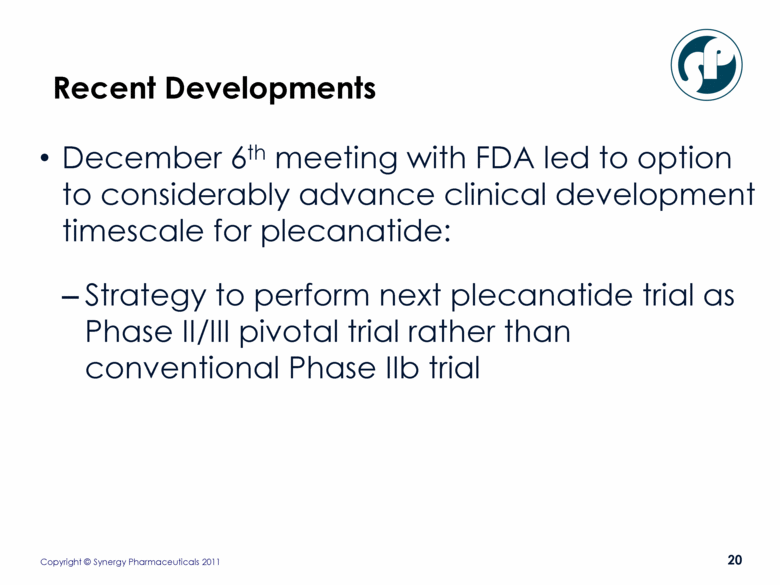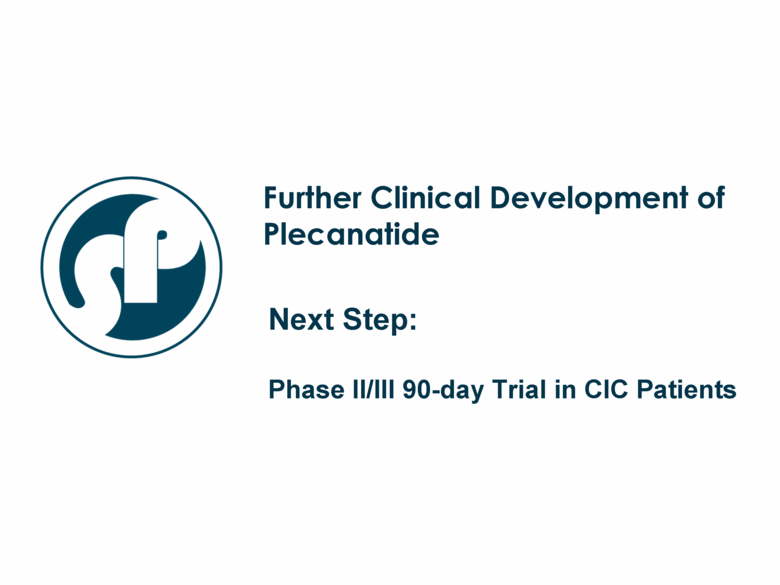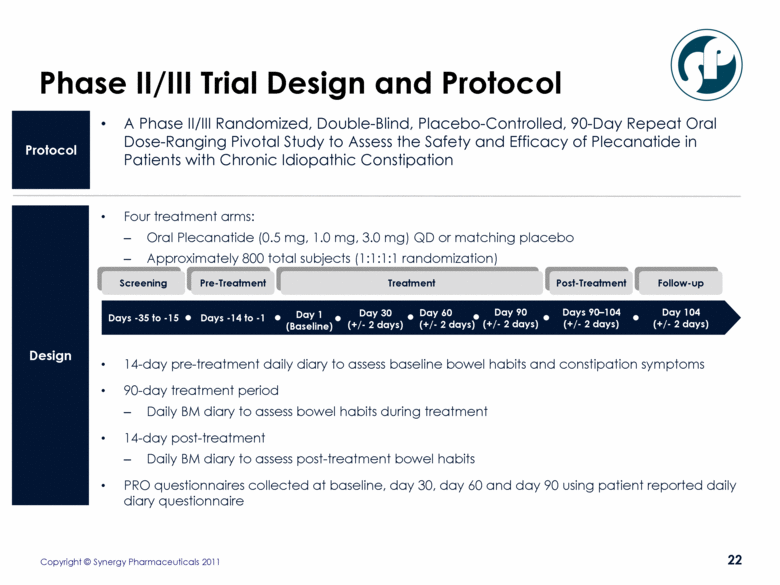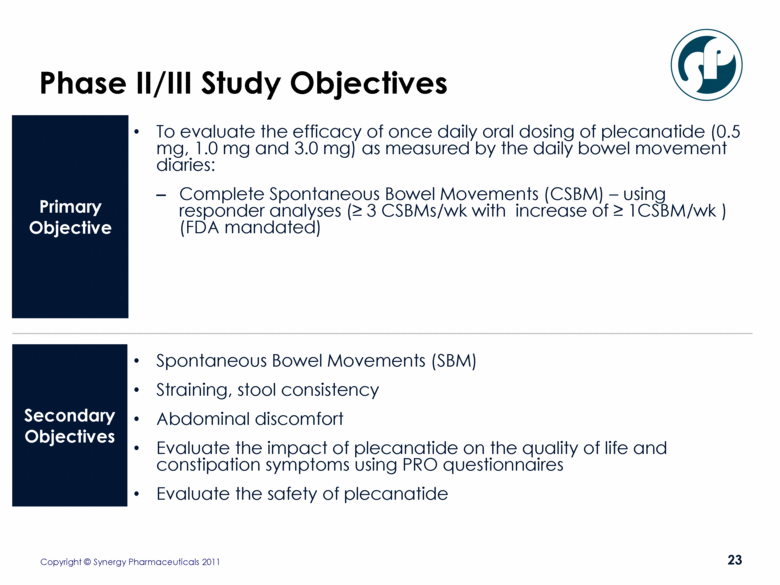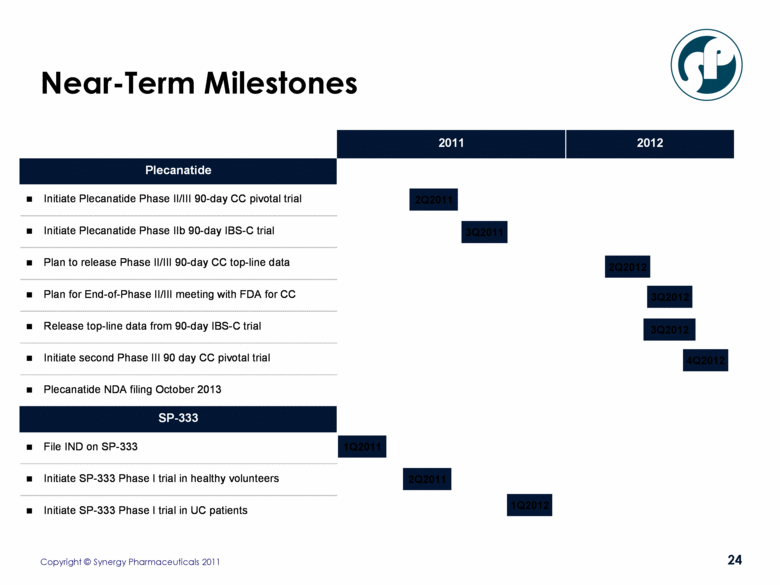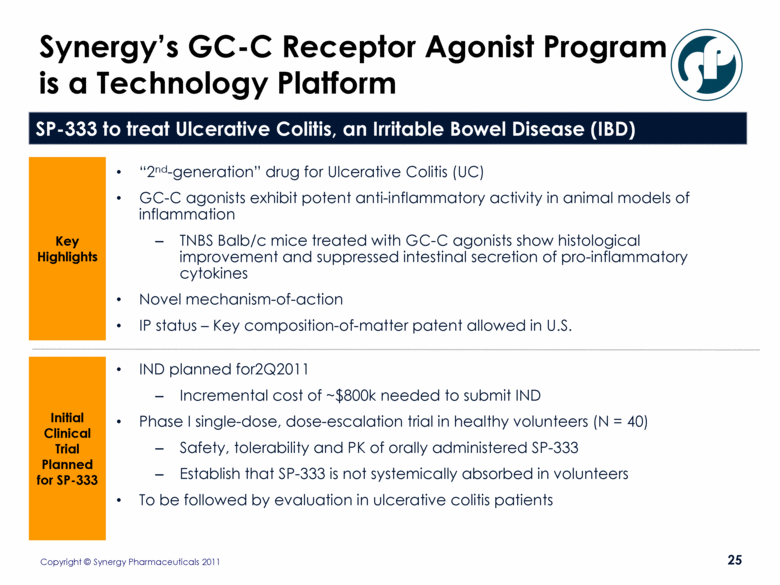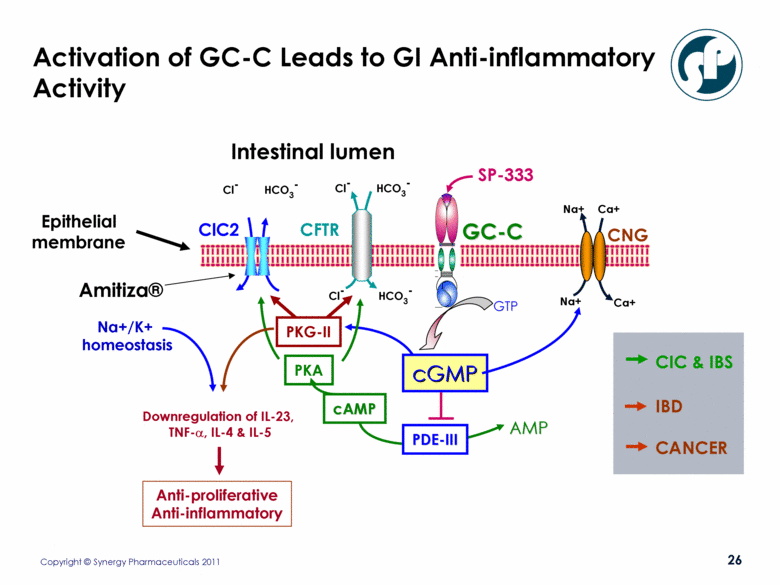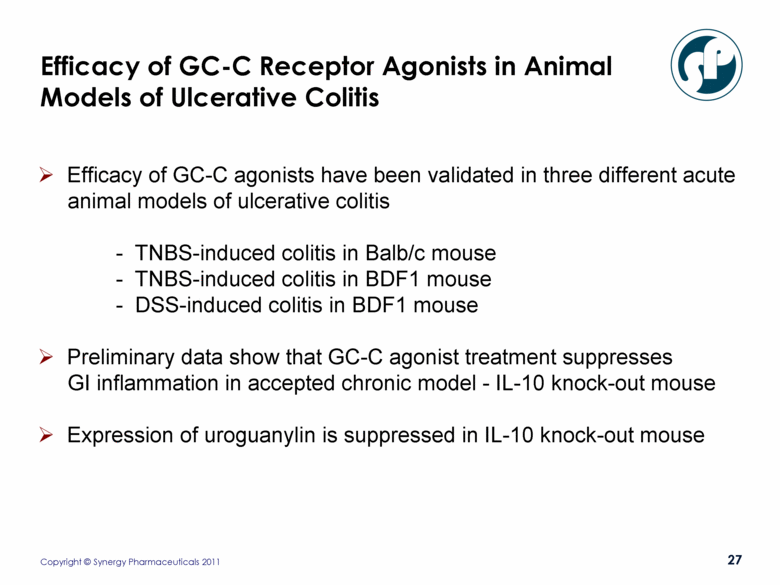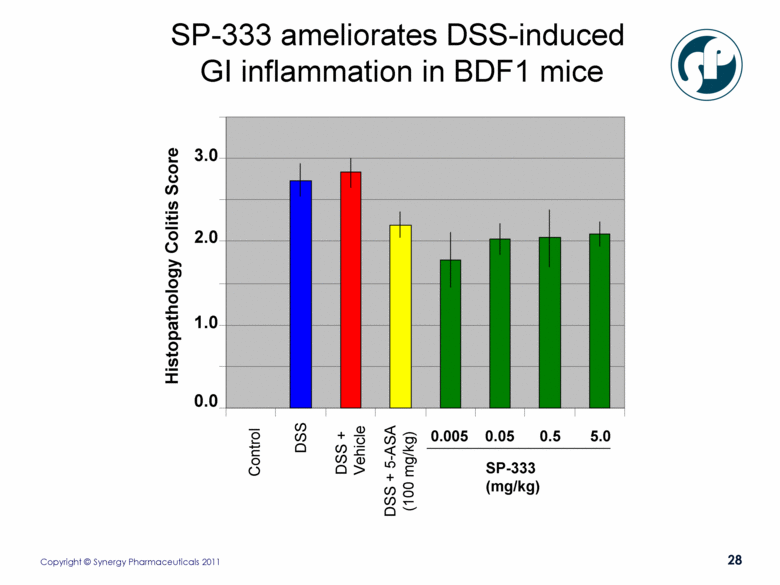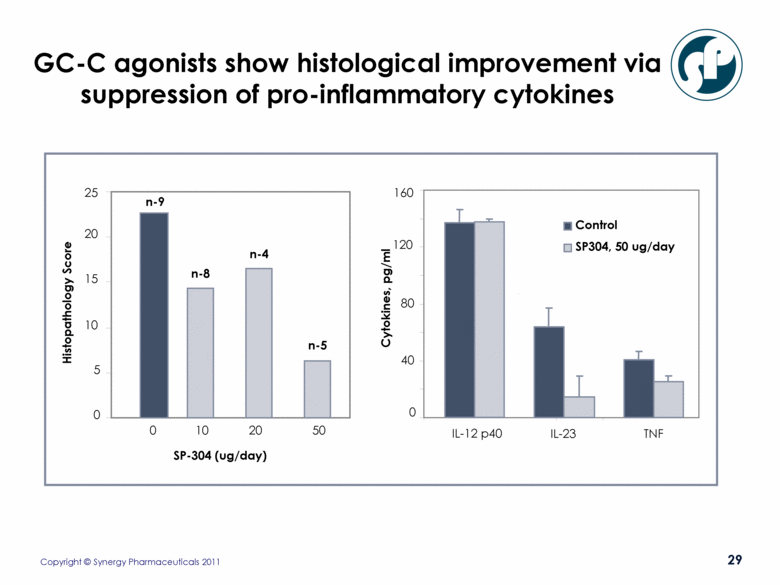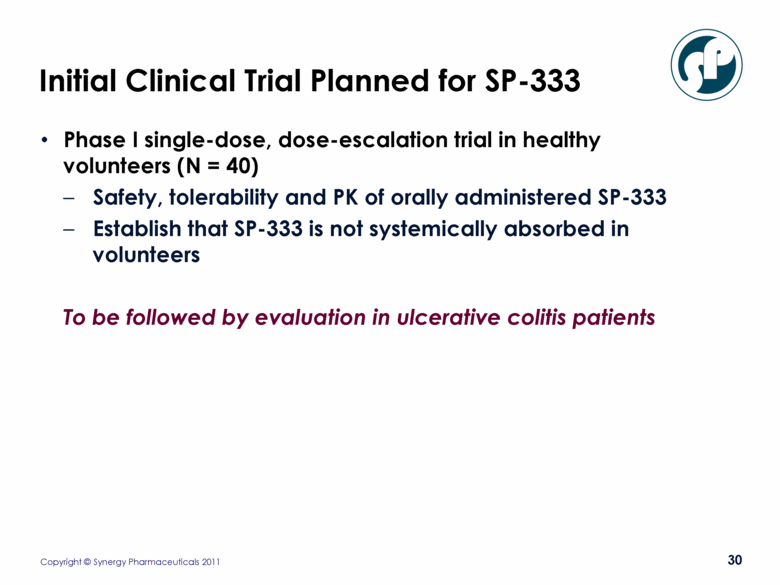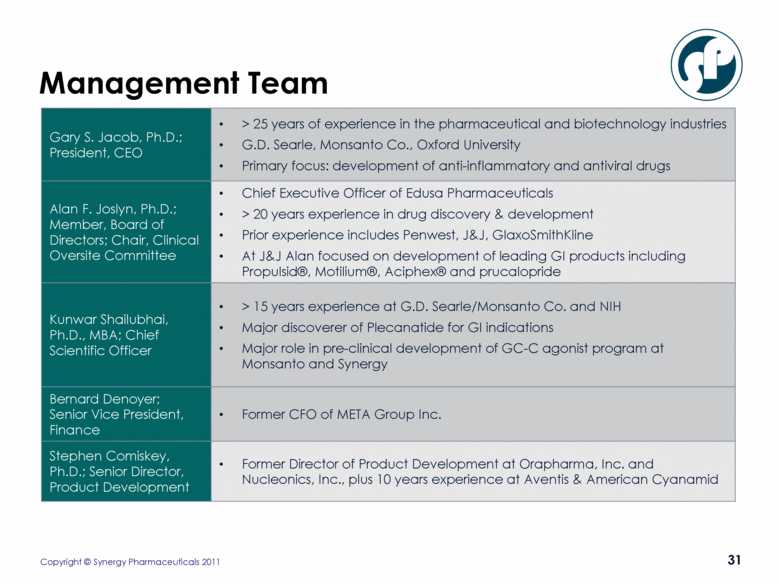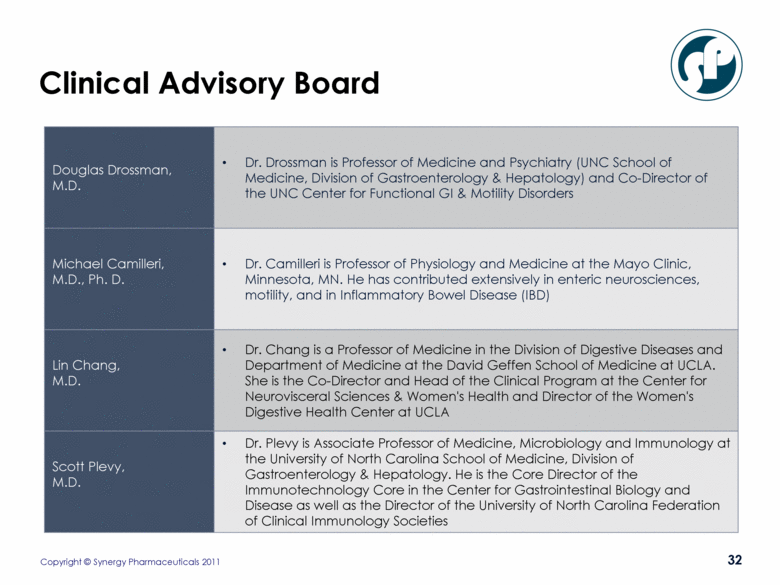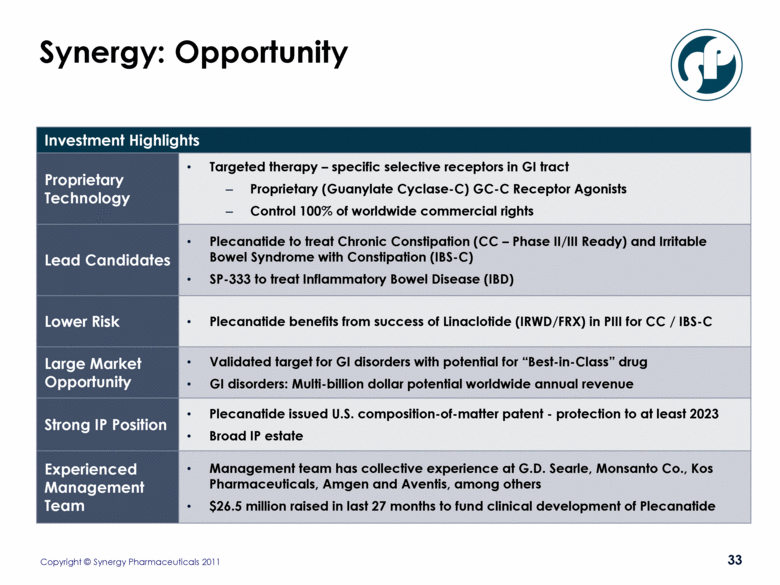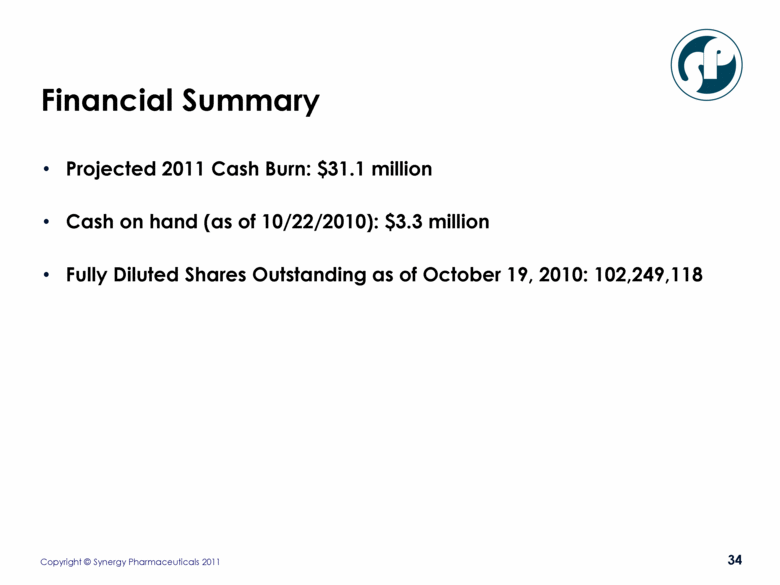Attached files
| file | filename |
|---|---|
| 8-K - 8-K - SYNERGY PHARMACEUTICALS, INC. | a11-4222_18k.htm |
Exhibit 99.1
|
|
Developing new Treatments for GI Disorders and Diseases January 10, 2011 |
|
|
Certain statements made in this presentation are forward-looking. Such statements are indicated by words such as “expect,” “should,” “anticipate” and similar words indicating uncertainty in facts and figures. Although Synergy believes that the expectations reflected in such forward-looking statements are reasonable, it can give no assurance that such expectations reflected in such forward-looking statements will prove to be correct. As discussed in the Synergy Pharmaceuticals Annual Report on Form 10-K for the year ended December 31, 2009, and other periodic reports, as filed with the Securities and Exchange Commission, actual results could differ materially from those projected in the forward-looking statements as a result of the following factors, among others: uncertainties associated with product development, the risk that products that appeared promising in early clinical trials do not demonstrate efficacy in larger-scale clinical trials, the risk that Synergy will not obtain approval to market its products, the risks associated with dependence upon key personnel and the need for additional financing. Forward-Looking Information |
|
|
Introduction to Synergy Pharmaceuticals Investment Highlights Proprietary Technology Targeted therapy – specific selective receptors in GI tract Proprietary (Guanylate Cyclase-C) GC-C Receptor Agonists Control 100% of worldwide commercial rights Lead Candidates Plecanatide to treat Chronic Constipation (CC – Phase II/III Ready) and Irritable Bowel Syndrome with Constipation (IBS-C) SP-333 to treat Inflammatory Bowel Disease (IBD) Lower Risk Plecanatide benefits from success of Linaclotide (IRWD/FRX) in PIII for CC / IBS-C Large Market Opportunity Validated target for GI disorders with potential for “Best-in-Class” drug GI disorders: Multi-billion dollar potential worldwide annual revenue Strong IP Position Plecanatide issued U.S. composition-of-matter patent - protection to at least 2023 Broad IP estate Experienced Management Team Management team has collective experience at G.D. Searle, Monsanto Co., Kos Pharmaceuticals, Amgen and Aventis, among others $26.5 million raised in last 27 months to fund clinical development of Plecanatide |
|
|
GI Disorders & Diseases Significant Market Opportunity |
|
|
IBS-C / CC – A Large and Growing Market >100 million people worldwide suffer from IBS-C / CC High incidence of severe form 20 million in U.S., Europe & Japan High prevalence in the U.S. ~15% of U.S. population or ~45 million people suffer from CC and IBS-C 6.0 - 8.5 million patients in U.S. with CC sought medical care in 2007 More than $2 Billion (2) Source: 2007 U.S. census data; Johanson & Kralstein, Aliment Pharmacol Ther, 25, (2007); Brandt et. al., Am. J. Gastroenterology, 100, (2005): Johanson & Kralstein, and Choung et. al., Aliment Pharmacol. Ther., 25, (2007), Wall Street research. (1) Per Cowen and Company’s Therapeutic Outlook Report – March 2010. (2) Assumes conservative (4.8%) market share by 2021, and based on similar pricing to present-day branded drug. A Large Global Patient Population (patients, mm) High Unmet Medical Need Strong Double-Digit Growth Total U.S. Market for Laxatives / IBS ($,mm) (1) Plecanatide Global Sales Potential ~45m ~55m ROW U.S 100 million IBS-C / CC patients worldwide 325 373 401 444 589 754 893 983 0 200 400 600 800 1000 1200 2008 2009 2010 2011 2012 2013 2014 2015 2008-2015 CAGR = 18% |
|
|
IBS-C / CC Competitive Landscape Source: Sucampo & Takeda annual reports, Movetis annual report, Ladenburg Thalmann research report, press releases. Amitiza® Resolor® Linaclotide Only late-stage drug currently in development in U.S. Indication Stage Mechanism of Action (MOA) Most Common Side Effect(s) Sales Commentary 2015E Sales = $550 million Diarrhea First-in-class GC-C receptor agonist NDA filing ~Mid. 2011, Potential Launch in 2012 IBS-C / CC Approved in Europe in October 2009 Estimated peak sales > €300 million Diarrhea, headache, nausea 5-HT4 agonist Marketed in Switzerland and UK CC in Women Sets high price for market ~$3.80 / day retail Only product approved in U.S. 2009A sales = $226 million Nausea (~30% of patients) Chloride C-2 channel activator Marketed in the U.S. and Japan IBS-C / CC Limited available therapies for patients; Diarrhea and Nausea represent common side effects |
|
|
GC-C Receptor Agonists |
|
|
Guanylate Cyclase C Receptor Agonists Physiological mechanism Cross section of the GI tract Activation of the GC-C receptors stimulates intracellular synthesis of cyclic GMP, resulting in activation of the Cystic Fibrosis Transmembrane Conductance Regulator (CFTR) The CFTR, when activated, secretes Cl- and HCO3- along with fluid into the intestinal lumen. Optimum volume of fluid secretion in the proximal intestine is critical for a normal digestion pattern 2 3 Uroguanylin (UroG) and Guanylin (GN) are physiological agonists of Guanylate Cyclase-C (GC-C) receptors present on the lumenal side of the gut 1 1 2 3 4 As an analogue of UroG, the natural human hormone, Plecanatide binds to the same GC-C receptors to promote spontaneous bowel movement (SBM) and reduce abdominal discomfort and bloating 4 Plecanatide |
|
|
Plecanatide – A Superior Analogue of Uroguanylin 16-mer analogue of natural uroguanylin Single key amino acid change Locked into stable active conformer Compact stable molecule Thermo and acid stable (100 °C, pH 2) High resistance to proteases Behaves like a small molecule drug More potent than the natural hormone NDDCELCVNVACTGCL NDECELCVNVACTGCL GC-C Receptor Uroguanylin (UroG) - Natural Hormone Plecanatide - Uroguanylin Analog Plecanatide binding constant to human GC-C receptors is 8-fold higher than uroguanylin (UroG) ST-peptide Produced by E. coli Bacteria NSSNYCCELCCNPACTGCY Linaclotide: ST-peptide Analog CCEYCCNPACTGCY |
|
|
Uroguanylin Plecanatide Plecanatide is a superior analog of the natural GI hormone uroguanylin N D D C E L C V N V A C T G C L N D E C E L C V N V A C T G C L |
|
|
Dominant IP against uroguanylin analogs Key U.S. patent on plecanatide issued in 2006 Issued in Europe Allowed in Japan Synergy has pursued a strategy with narrow but strong claims Ironwood crafted their IP position primarily against ST-peptide analogs Pursued a broad strategy - filed thousands of peptide sequences to create a “fence” around the area – most of these claims will not issue but will publish Patent on linaclotide issued in December, 2008 Strong IP Position Patent No. US 7,041,786 Date of Patent May 9, 2006 Title Guanylate cyclase receptor agonists for the treatment of tissue inflammation and carcinogenesis Inventors K. Shailubhai, G. Nikiforovich, G. Jacob Assignee Synergy Pharmaceuticals Key U.S. Composition-of-Matter Patent Strong Patent Protection To At Least 2023 |
|
|
Plecanatide Clinical Development |
|
|
Protocol No. SP-SP304101-08 Cohorts administered a single, oral dose of 0.1, 0.3, 0.9, 2.7, 5.4, 8.1,16.2, 24.3 and 48.6 mg Plecanatide or matching placebo 8 subjects per cohort 6 Plecanatide 2 Placebo 71 subjects total No systemic absorption of Plecanatide observed at any administered dose PK collected through 48 hours post-dose Plecanatide was well-tolerated Did not reach a maximum tolerated dosage (MTD) No serious adverse events (AEs) reported Minimal AEs reported Plecanatide Phase I Trial in Volunteers Study Summary Phase I Trial – Single-site, Randomized, Double-blind, Placebo-Controlled, Safety, Tolerability and Pharmacokinetic Study |
|
|
A Phase IIa Randomized, Double-Blind, Placebo-Controlled, 14-Day Repeat, Oral, Dose-Ranging Study to Assess the Safety, Pharmacokinetic and Pharmacodynamic Effects of Plecanatide in Patients with Chronic Idiopathic Constipation (Protocol No. SP-SP304201-09) ROME III enrollment criteria Four dose cohorts in trial: Plecanatide (0.3 mg, 1.0 mg, 3.0 mg or 9.0 mg) QD in the A.M. and matching placebo for 14 days 20 subjects per dose cohort, 3:1 randomization Endpoints: Protocol Design Phase IIa Trial Design Days -28 to -14 Days -14 to -1 Day 1 to Day 7 (+/- 1 day) Day 21 (+/- 3 days) Screening Pre-Treatment Follow-up Treatment Day 8 to Day 14 Primary Secondary To collect bowel habit information on patients To assess the pharmacokinetic profile To assess the time to first bowel movement after first daily dose To assess changes in bowel habits (frequency, completeness of evacuation, stool consistency, straining and abdominal discomfort) Quality of life To evaluate safety |
|
|
Demographics: Primarily females (>80%) of Caucasian descent with mean age per cohort ranging from 47 to 51 years old (1) No detectable systemic absorption of Plecanatide Assay sensitivity >10 ng/mL No serious adverse events (SAE) reported in subjects receiving Plecanatide No deaths reported in this study Majority of adverse events (AE) were mild/moderate and transient in nature Summary of Data Adverse Events Related to Study Drug AE Placebo n=20 0.3 mg n=14 1.0 mg n=14 3.0 mg n=15 9.0 mg n=15 Abdominal Cramping 1 (5.0%) 0 0 0 0 Abdominal Pain 1 (5.0%) 0 0 0 0 Bloating 0 0 0 0 1 (6.7%) Diarrhea 1 (5.0%) 0 0 0 0 Flatulence 2 (10.0%) 0 0 0 0 Nausea 0 1 (7.1%) 0 0 1 (6.7%) Phase IIa Safety Findings No diarrhea reported by any subject receiving Plecanatide (1) The standard deviation per cohort ranged from 10.6 to 16.1 |
|
|
Median Time to First Bowel Movement after Administration of First Daily Dose Change from Baseline in Spontaneous Bowel Movements (SBM) after 14-Days of Treatment (Per Protocol Population) Phase IIa Study Findings and Conclusions More than 50% of the population have 1st-bowel movement within 5 hours vs. 22 hours for Placebo. Plecanatide also demonstrates an increase in number of Spontaneous and Spontaneous Complete Bowel Movements Plecanatide Dose (mg) n=16 n=13 n=14 n=13 n=15 n=55 0.0 1.0 2.0 3.0 4.0 5.0 6.0 Placebo 0.3mg 1.0mg 3.0mg 9.0mg Overall Tx Average Difference in Number of SBM Change from Baseline in Complete Spontaneous Bowel Movements (CSBM) after 14-Days of Treatment (Per Protocol Population) Change in Average Number of CSBM Plecanatide Dose (mg) n=16 n=13 n=14 n=13 n=15 n=55 0 5 10 15 20 25 Placebo 0.3 mg 1.0 mg 3.0 mg 9.0 mg All Median Time to First BM (Hours) Plecanatide Dose (mg) n=16 n=12 n=14 n=13 n=15 n=54 0.0 1.0 2.0 3.0 4.0 5.0 Placebo 0.3mg 1.0mg 3.0mg 9.0mg Overall Tx |
|
|
Complete Spontaneous Bowel Movements (CSBM) pre-treatment and after 14-Days of Treatment (Per Protocol Population) Bristol Stool Form Score (BSFS) pre-treatment and after 14-Days of Treatment (Per Protocol Population) Study Findings and Conclusions (cont’d) 0.0 1.0 2.0 3.0 4.0 5.0 Placebo 0.3 mg 1.0 mg 3.0 mg 9.0 mg Overall Tx Plecanatide Dose (mg) Average Weekly BSFS 0.0 1.0 2.0 3.0 4.0 5.0 Placebo 0.3 mg 1.0 mg 3.0 mg 9.0 mg Overall Tx Plecanatide Dose (mg) Average Number of CSBM/wk Pre-Treatment 14-Day Treatment |
|
|
Change from Baseline in Bristol Stool Form Score (BSFS) after 14-Days of Treatment (Per Protocol Population) Phase IIa Study Findings and Conclusions (cont’d) Plecanatide Dose (mg) 0.0 0.5 1.0 1.5 2.0 2.5 Placebo 0.3mg 1.0mg 3.0mg 9.0mg Overall Tx Average Difference in BSFS Secondary endpoints such as stool consistency (BSFS) and straining scores are improved following treatment with Plecanatide Change from Baseline in Straining Scores after 14-Days of Treatment (Per Protocol Population) 5.0 n=16 n=13 n=14 n=13 n=15 n=55 Change in Average Straining Scores Plecanatide Dose (mg) 0.0 1.0 2.0 3.0 4.0 Placebo 0.3mg 1.0mg 3.0mg 9.0mg Overall Tx n=16 n=13 n=14 n=13 n=15 n=55 |
|
|
% of Subjects Reporting Improvement in Abdominal Discomfort 0 20 40 60 80 Placebo 0.3 mg 1.0 mg 3.0 mg 9.0 mg Overall Tx % Subjects Reporting Improvement in Abdominal Discomfort Scores after 14-day Treatment Other key secondary endpoints including abdominal discomfort, constipation severity and overall relief are also improved following treatment with Plecanatide Phase IIa Study Findings and Conclusions (cont’d) Patient Global Assessment Questionnaire – Constipation Severity Plecanatide Dose (mg) 80 % of Subjects Reporting Improvement in Constipation Severity 0 20 40 60 Placebo 0.3 mg 1.0 mg 3.0 mg 9.0 mg Overall Tx Patient Global Assessment Questionnaire – Overall Relief % of Subjects Reporting Overall Relief Placebo 0.3 mg 1.0 mg 3.0 mg 9.0 mg Overall Tx 0 20 40 60 80 100 14-Day Treatment n=16 n=13 n=14 n=13 n=15 n=55 n=16 n=13 n=14 n=13 n=15 n=55 n=16 n=13 n=14 n=13 n=15 n=55 |
|
|
Recent Developments December 6th meeting with FDA led to option to considerably advance clinical development timescale for plecanatide: Strategy to perform next plecanatide trial as Phase II/III pivotal trial rather than conventional Phase IIb trial |
|
|
Further Clinical Development of Plecanatide Next Step: Phase II/III 90-day Trial in CIC Patients |
|
|
A Phase II/III Randomized, Double-Blind, Placebo-Controlled, 90-Day Repeat Oral Dose-Ranging Pivotal Study to Assess the Safety and Efficacy of Plecanatide in Patients with Chronic Idiopathic Constipation Four treatment arms: Oral Plecanatide (0.5 mg, 1.0 mg, 3.0 mg) QD or matching placebo Approximately 800 total subjects (1:1:1:1 randomization) 14-day pre-treatment daily diary to assess baseline bowel habits and constipation symptoms 90-day treatment period Daily BM diary to assess bowel habits during treatment 14-day post-treatment Daily BM diary to assess post-treatment bowel habits PRO questionnaires collected at baseline, day 30, day 60 and day 90 using patient reported daily diary questionnaire Days -35 to -15 Days -14 to -1 Day 1 (Baseline) Day 30 (+/- 2 days) Day 104 (+/- 2 days) Days 90–104 (+/- 2 days) Day 90 (+/- 2 days) Screening Pre-Treatment Follow-up Post-Treatment Treatment Protocol Design Phase II/III Trial Design and Protocol Day 60 (+/- 2 days) |
|
|
Phase II/III Study Objectives To evaluate the efficacy of once daily oral dosing of plecanatide (0.5 mg, 1.0 mg and 3.0 mg) as measured by the daily bowel movement diaries: Complete Spontaneous Bowel Movements (CSBM) – using responder analyses (> 3 CSBMs/wk with increase of > 1CSBM/wk ) (FDA mandated) Primary Objective Secondary Objectives Spontaneous Bowel Movements (SBM) Straining, stool consistency Abdominal discomfort Evaluate the impact of plecanatide on the quality of life and constipation symptoms using PRO questionnaires Evaluate the safety of plecanatide |
|
|
2Q2011 Near-Term Milestones 3Q2011 3Q2012 2Q2012 3Q2012 4Q2012 1Q2011 2Q2011 1Q2012 2011 2012 Plecanatide Initiate Plecanatide Phase II/III 90-day CC pivotal trial Initiate Plecanatide Phase IIb 90-day IBS-C trial Plan to release Phase II/III 90-day CC top-line data Plan for End-of-Phase II/III meeting with FDA for CC Release top-line data from 90-day IBS-C trial Initiate second Phase III 90 day CC pivotal trial Plecanatide NDA filing October 2013 SP-333 File IND on SP-333 Initiate SP-333 Phase I trial in healthy volunteers Initiate SP-333 Phase I trial in UC patients |
|
|
Synergy’s GC-C Receptor Agonist Program is a Technology Platform “2nd-generation” drug for Ulcerative Colitis (UC) GC-C agonists exhibit potent anti-inflammatory activity in animal models of inflammation TNBS Balb/c mice treated with GC-C agonists show histological improvement and suppressed intestinal secretion of pro-inflammatory cytokines Novel mechanism-of-action IP status – Key composition-of-matter patent allowed in U.S. SP-333 to treat Ulcerative Colitis, an Irritable Bowel Disease (IBD) Key Highlights Initial Clinical Trial Planned for SP-333 IND planned for2Q2011 Incremental cost of ~$800k needed to submit IND Phase I single-dose, dose-escalation trial in healthy volunteers (N = 40) Safety, tolerability and PK of orally administered SP-333 Establish that SP-333 is not systemically absorbed in volunteers To be followed by evaluation in ulcerative colitis patients |
|
|
Activation of GC-C Leads to GI Anti-inflammatory Activity Epithelial membrane cAMP AMP PKA PDE-III GTP PKG-II cGMP Na+ Ca+ Na+ Ca+ Cl- HCO3- HCO3- Cl- ClC2 CFTR CNG GC-C SP-333 Anti-proliferative Anti-inflammatory Cl- HCO3- Na+/K+ homeostasis Amitiza® CIC & IBS IBD CANCER Intestinal lumen Downregulation of IL-23, TNF- a, IL-4 & IL-5 |
|
|
Efficacy of GC-C agonists have been validated in three different acute animal models of ulcerative colitis - TNBS-induced colitis in Balb/c mouse - TNBS-induced colitis in BDF1 mouse - DSS-induced colitis in BDF1 mouse Preliminary data show that GC-C agonist treatment suppresses GI inflammation in accepted chronic model - IL-10 knock-out mouse Expression of uroguanylin is suppressed in IL-10 knock-out mouse Efficacy of GC-C Receptor Agonists in Animal Models of Ulcerative Colitis |
|
|
SP-333 ameliorates DSS-induced GI inflammation in BDF1 mice 0.0 1.0 2.0 3.0 Histopathology Colitis Score Control DSS DSS + Vehicle DSS + 5-ASA (100 mg/kg) 0.005 0.05 0.5 5.0 SP-333 (mg/kg) |
|
|
GC-C agonists show histological improvement via suppression of pro-inflammatory cytokines 0 40 80 120 IL-12 p40 IL-23 TNF Cytokines, pg/ml Control SP304, 50 ug/day 160 0 5 10 15 20 25 Histopathology Score SP-304 (ug/day) 0 10 20 50 n-9 n-8 n-4 n-5 |
|
|
Initial Clinical Trial Planned for SP-333 Phase I single-dose, dose-escalation trial in healthy volunteers (N = 40) Safety, tolerability and PK of orally administered SP-333 Establish that SP-333 is not systemically absorbed in volunteers To be followed by evaluation in ulcerative colitis patients |
|
|
Gary S. Jacob, Ph.D.; President, CEO > 25 years of experience in the pharmaceutical and biotechnology industries G.D. Searle, Monsanto Co., Oxford University Primary focus: development of anti-inflammatory and antiviral drugs Alan F. Joslyn, Ph.D.; Member, Board of Directors; Chair, Clinical Oversite Committee Chief Executive Officer of Edusa Pharmaceuticals > 20 years experience in drug discovery & development Prior experience includes Penwest, J&J, GlaxoSmithKline At J&J Alan focused on development of leading GI products including Propulsid®, Motilium®, Aciphex® and prucalopride Kunwar Shailubhai, Ph.D., MBA; Chief Scientific Officer > 15 years experience at G.D. Searle/Monsanto Co. and NIH Major discoverer of Plecanatide for GI indications Major role in pre-clinical development of GC-C agonist program at Monsanto and Synergy Bernard Denoyer; Senior Vice President, Finance Former CFO of META Group Inc. Stephen Comiskey, Ph.D.; Senior Director, Product Development Former Director of Product Development at Orapharma, Inc. and Nucleonics, Inc., plus 10 years experience at Aventis & American Cyanamid Management Team |
|
|
Clinical Advisory Board Douglas Drossman, M.D. Dr. Drossman is Professor of Medicine and Psychiatry (UNC School of Medicine, Division of Gastroenterology & Hepatology) and Co-Director of the UNC Center for Functional GI & Motility Disorders Michael Camilleri, M.D., Ph. D. Dr. Camilleri is Professor of Physiology and Medicine at the Mayo Clinic, Minnesota, MN. He has contributed extensively in enteric neurosciences, motility, and in Inflammatory Bowel Disease (IBD) Lin Chang, M.D. Dr. Chang is a Professor of Medicine in the Division of Digestive Diseases and Department of Medicine at the David Geffen School of Medicine at UCLA. She is the Co-Director and Head of the Clinical Program at the Center for Neurovisceral Sciences & Women's Health and Director of the Women's Digestive Health Center at UCLA Scott Plevy, M.D. Dr. Plevy is Associate Professor of Medicine, Microbiology and Immunology at the University of North Carolina School of Medicine, Division of Gastroenterology & Hepatology. He is the Core Director of the Immunotechnology Core in the Center for Gastrointestinal Biology and Disease as well as the Director of the University of North Carolina Federation of Clinical Immunology Societies |
|
|
Synergy: Opportunity Investment Highlights Proprietary Technology Targeted therapy – specific selective receptors in GI tract Proprietary (Guanylate Cyclase-C) GC-C Receptor Agonists Control 100% of worldwide commercial rights Lead Candidates Plecanatide to treat Chronic Constipation (CC – Phase II/III Ready) and Irritable Bowel Syndrome with Constipation (IBS-C) SP-333 to treat Inflammatory Bowel Disease (IBD) Lower Risk Plecanatide benefits from success of Linaclotide (IRWD/FRX) in PIII for CC / IBS-C Large Market Opportunity Validated target for GI disorders with potential for “Best-in-Class” drug GI disorders: Multi-billion dollar potential worldwide annual revenue Strong IP Position Plecanatide issued U.S. composition-of-matter patent - protection to at least 2023 Broad IP estate Experienced Management Team Management team has collective experience at G.D. Searle, Monsanto Co., Kos Pharmaceuticals, Amgen and Aventis, among others $26.5 million raised in last 27 months to fund clinical development of Plecanatide |
|
|
Financial Summary Projected 2011 Cash Burn: $31.1 million Cash on hand (as of 10/22/2010): $3.3 million Fully Diluted Shares Outstanding as of October 19, 2010: 102,249,118 |

